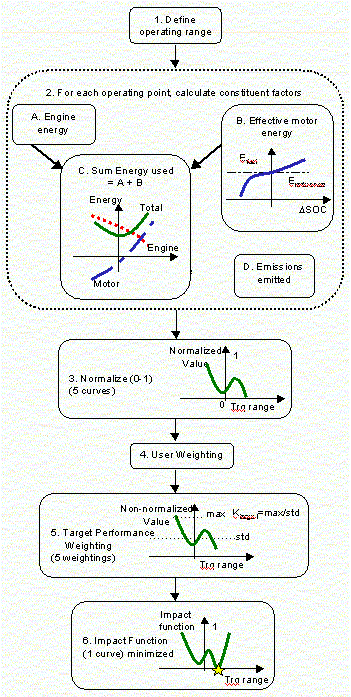
Role of subsystem in vehicle
The Adaptive Control Strategy (ACS) for a parallel hybrid considers both fuel economy and emissions in its choice of operating points. ACS attempts to optimize at each time step the torque distribution between the electric motor and the engine
Description of modeling approach
Over the valid range of operating torques, ACS normalizes five competing metrics (energy use, HC, CO, NOx, and PM emissions) by using user- and standards-based weightings of time-averaged fuel economy and emissions performance determine an overall impact function. The Adaptive Control Strategy has the following characteristics:
The ACS calculations follow the 6-step path described in the figure below.

A sample Impact function is shown below.

For detailed information on the implementation, see the paper and presentation presented at FutureCar Congress (April, 2000).
Variables used in subsystem
There are 13 variables that determine the operation of the Adaptive Control Strategy.
| Variable | Description |
| cs_hi_soc | highest desired battery state of charge |
| cs_lo_soc | lowest desired battery state of charge |
| cs_soc_range | SOC index for cs_scale_factor |
| cs_scale_factor | Scale factor by which to multiply electrical energy cost. Allows for SOC balancing |
| cs_regen_avg_time | Averaging time for looking at free regenerative braking |
| cs_mph_avg_time | Averaging time for looking at vehicle speed (which is used in determining operating performance with respect to desired metrics) |
| K_Energy | Weight for energy usage, cannot be zero, may be >=1 |
| K_Emis | Weight for emissions [HC CO NOx PM] in picking operating point. 0=ignore that emission, >0(e.g. 1)=include analysis of that emission |
| mpg_desired | Desired fuel economy (affects weighting in the performance function) |
| hc_desired | Desired HC emissions |
| co_desired | Desired CO emissions |
| nox_desired | Desired NOx emissions |
| pm_desired | Desired PM emissions |
Last Revised: 02/08/01:VHJ